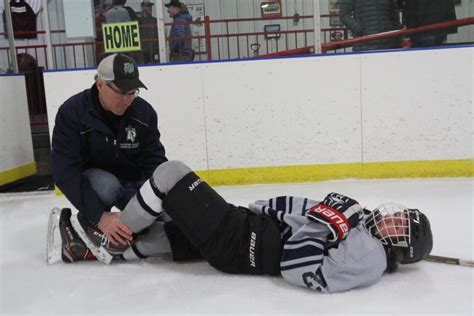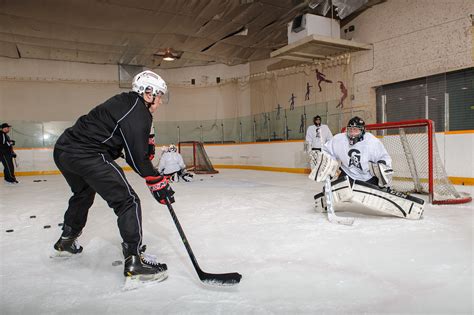Discover essential insights on hockey injury prevention, including warm-up routines, strength training, proper equipment, and nutrition tips to keep players safe and healthy.Hockey is an exhilarating sport that demands skill, speed, and agility; however, it also comes with a significant risk of injuries. For players at all levels, understanding how to prevent these injuries can make the difference between a successful season and time spent on the sidelines. This article delves into essential injury prevention tips specifically designed for hockey players. From recognizing common injuries and implementing effective warm-up routines to the importance of strength training, proper equipment, and nutrition, we will guide you through practical strategies to keep you in the game. Whether you’re a seasoned pro or just starting out, these insights will empower you to play safely and confidently while minimizing the risk of injuries on the ice.
Understanding Common Injuries In Hockey
Hockey is an intense and physically demanding sport, which unfortunately makes players susceptible to a variety of injuries. Understanding the common injuries that occur in hockey can aid in injury prevention strategies and ensure players remain on the ice longer. Here are some of the most frequently encountered injuries:
- Concussions: Hockey players are at risk for concussions due to hits, falls, and collisions. Symptoms can include headaches, dizziness, and confusion.
- Shoulder Injuries: These can include sprains, dislocations, and fractures, often resulting from falls or body checks.
- Knee Injuries: Common knee injuries in hockey include anterior cruciate ligament (ACL) tears and meniscus injuries, typically attributed to sudden stops or awkward landings.
- Wrist Injuries: Players can suffer from sprains or fractures in their wrists due to falls or when using the stick forcefully.
- Muscle Strains: Strains often occur in the groin, hamstrings, or quadriceps, primarily as a result of overexertion during intense skating or agility drills.
By being aware of these injuries, players can take proactive measures in their training and gameplay to effectively reduce their risk and enhance their overall performance on the ice. Implementing comprehensive injury prevention strategies can significantly improve player safety and longevity in the sport.
Essential Warm-Up Routines For Injury Prevention
Effective injury prevention starts with an appropriate warm-up routine. A proper warm-up prepares the body for the intense physical demands of hockey and helps reduce the risk of injuries. Here are some essential warm-up exercises designed specifically for hockey players:
| Warm-Up Exercise | Description | Duration |
|---|---|---|
| Dynamic Stretching | Engage in leg swings, arm circles, and trunk twists to increase blood flow and mobility. | 5-10 minutes |
| Movement Drills | Perform shuttle runs or lateral slides to mimic game movements and improve agility. | 5-10 minutes |
| Plyometrics | Incorporate jump squats or box jumps to enhance explosive strength and conditioning. | 5 minutes |
| Sport-Specific Skills | Practice skating strides, puck handling, and passing drills to get in the right mindset. | 5-10 minutes |
Incorporating these warm-up routines into your pre-game or practice sessions can significantly enhance injury prevention efforts. Always focus on your body’s signals and avoid pushing through discomfort. Gradually increase intensity and duration as your fitness level improves.
Strength Training Techniques To Reduce Injury Risk
Incorporating targeted strength training techniques is vital for hockey players looking to enhance their physical performance while minimizing the risk of injuries. By focusing on specific areas of the body, players can develop strength, stability, and endurance necessary for the demands of the game. Below are several effective strength training techniques that can aid in injury prevention.
| Exercise | Target Muscle Group | Description |
|---|---|---|
| Squats | Legs and Core | Helps in building lower body strength and stability, crucial for skating power and balance. |
| Deadlifts | Back and Legs | Strengthens the posterior chain, enhancing overall core stability and reducing the risk of lower back injuries. |
| Bench Press | Chest, Shoulders, and Triceps | Increases upper body strength, which is important for shooting and physical battles on the ice. |
| Planks | Core | Improves core stability, essential for balance and control during movement. |
| Lunges | Legs and Core | Promotes leg strength and balance, important for rapid direction changes on the ice. |
In addition to these exercises, it’s essential to incorporate injury prevention strategies by paying attention to form and technique. Players should work with coaches or trainers to ensure they are performing exercises correctly to avoid strain or injury. Moreover, integrating plyometric exercises, such as jump squats and box jumps, can enhance explosive power and agility, crucial elements in hockey performance.
Regularly updating and varying strength training routines will keep players engaged and target different muscle groups, ultimately contributing to better overall fitness and lower injury risk. By implementing these strength training techniques, hockey players can better prepare their bodies for the rigors of the sport, significantly enhancing their performance while also prioritizing injury prevention.
The Role Of Proper Equipment In Injury Prevention
Wearing the right gear is crucial in ensuring injury prevention for hockey players. Protective equipment serves as the first line of defense against various injuries that can occur during gameplay. Here are some essential pieces of equipment and their roles in injury prevention:
- Helmets: A well-fitted helmet protects the head from concussions and other traumatic brain injuries. Impact-absorbing materials in modern helmets can greatly reduce the risk of severe injury.
- Shoulder Pads: These pads shield the upper body from collisions and falls, helping to prevent shoulder dislocations and fractures.
- Elbow Pads: Protecting the elbows from hits and falls is vital to avoid injuries such as sprains and fractures.
- Shin Guards: Essential for protecting the lower legs, shin guards help to absorb impacts from pucks or sticks, reducing the risk of contusions and breaks.
- Skates: Properly fitted skates not only enhance performance but also provide ankle support, reducing the risk of sprains and other foot-related injuries.
- Neck Guards: Though often overlooked, neck guards can protect against cuts and injuries in the critical neck area during play.
- Cups and Jockstraps: Protection for the groin area is essential, as this is a common site of injury in hockey.
Investing in high-quality, fitted protective gear tailored to a player’s individual needs can significantly lower the risk of injuries. Regularly checking for wear and replacing old or damaged equipment is also a key aspect of maintaining safety on the ice. By prioritizing the use of proper equipment, hockey players can enhance their overall safety and contribute to injury prevention on the ice.
Nutrition Tips To Support Injury Prevention In Hockey Players
Proper nutrition is a crucial component of injury prevention for hockey players. A well-balanced diet not only enhances performance on the ice but also strengthens the body, making it more resilient to injuries. Here are several key nutrition tips to keep in mind:
1. Fuel with Balanced Macronutrients
Ensure your meals include a healthy balance of carbohydrates, proteins, and fats. Carbs provide the energy needed during high-intensity games and practices, proteins help repair and rebuild muscle tissues, while healthy fats support overall health and hormone production.
2. Stay Hydrated
Dehydration can lead to muscle fatigue and increase the risk of injury. Make sure to drink plenty of water throughout the day and consider electrolyte drinks during intense practices or games to replenish lost fluids.
3. Include Anti-Inflammatory Foods
Incorporating foods that have anti-inflammatory properties can help reduce the risk of injuries. Foods like berries, salmon, spinach, leafy greens, nuts, and olive oil are beneficial in managing inflammation.
4. Don’t Skip Breakfast
A nutritious breakfast is essential for maintaining energy levels throughout the day. Aim for a meal that contains whole grains, protein, and healthy fats, such as oatmeal topped with nuts and fruit or a smoothie with spinach and protein powder.
5. Consider Meal Timing
Timing your meals and snacks around your training sessions can optimize performance. Focus on eating a carb-rich snack about 30-60 minutes before practicing or playing to provide quick energy, and refuel within 30 minutes post-activity to support recovery.
6. Supplements and Vitamins
While it’s best to get nutrients from natural food sources, some players may benefit from supplements. Vitamin D, omega-3 fatty acids, and protein supplements can play a role in supporting overall health, repair, and injury prevention. However, consult with a healthcare professional before starting any supplements.
| Food Group | Examples | Benefits |
|---|---|---|
| Carbohydrates | Whole grains, fruits, vegetables | Energy for performance |
| Proteins | Lean meats, dairy, legumes | Muscle recovery and repair |
| Fats | Nuts, avocados, fish | Hormone production, sustained energy |
By following these nutrition tips, hockey players can significantly enhance their body’s resilience, support their performance, and effectively contribute to injury prevention efforts both on and off the ice.
Frequently Asked Questions
What are some general injury prevention tips for hockey players?
Hockey players can prevent injuries by consistently warming up before games, maintaining strength and conditioning, using proper equipment, and practicing good technique.
Why is warming up important for hockey players?
Warming up increases blood flow to the muscles, improves flexibility, and prepares the body for the physical demands of the game, reducing the risk of strains and sprains.
What types of equipment should hockey players focus on for injury prevention?
Hockey players should invest in high-quality helmets, mouthguards, shoulder pads, shin guards, and skates. Properly fitted equipment can help prevent head injuries, dental injuries, and other impacts.
How can strength training aid in preventing hockey injuries?
Strength training helps enhance muscle strength and balance, which supports joints and protects against injuries. It can also improve performance on the ice.
What role does proper technique play in preventing injuries?
Using proper technique during skating, shooting, and checking reduces the risk of awkward falls or collisions that can lead to injuries.
Are there specific stretches or exercises that hockey players should include in their routine?
Yes, hockey players should include dynamic stretches for legs and hips, strengthening exercises for core stability, and flexibility exercises for the hamstrings and groin in their routines.
What should players do if they experience pain or discomfort during play?
Players should address any pain or discomfort immediately by resting, icing the affected area, and seeking medical attention if necessary. Ignoring symptoms can lead to more serious injuries.









